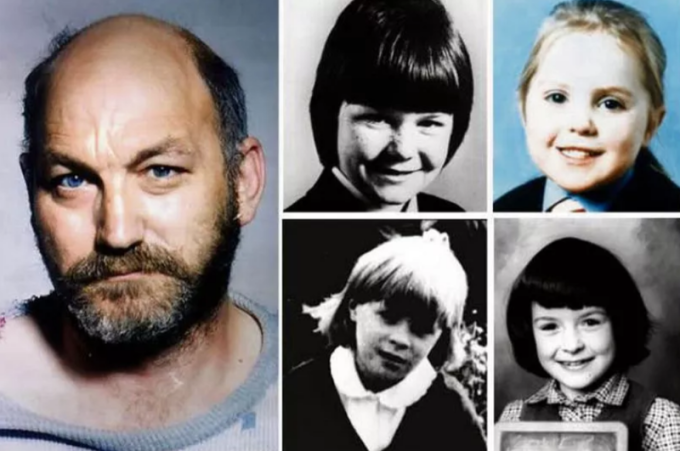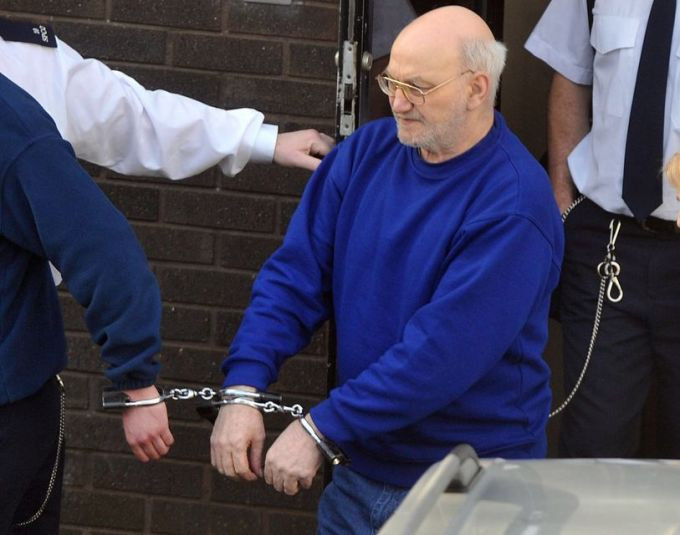Robert Black kidnapped, raped and murdered four girls in a series of crimes between 1981 and 1986 that led to the country's longest and most expensive manhunt, costing £12m and 22 tonnes of documents.

The Robert Black Inquest was one of the longest, most comprehensive and most expensive murder investigations in the United Kingdom in the 20th century. The case file was estimated to weigh 22 tonnes. The total cost of the inquest was estimated at £12 million.
On July 14, 1990, while mowing his front lawn, David Herkes, 53, saw a blue truck slowing down and stopping across the street. The driver got out of the car and wiped the windshield, just as his neighbor’s 6-year-old daughter walked by.
As David bent down to clear the grass, he saw the girl’s legs lift off the sidewalk and immediately straightened up. He saw the driver hastily push something through the passenger door, then climb into the driver’s seat, close the door, and start the car.
Realizing he had just witnessed a kidnapping, David wrote down the license plate number as it sped away. He ran to a neighbor's house to report the news, and the girl's mother immediately called the police.
Within minutes, six police cars arrived in Stow. As David described the van to the officers, he suddenly saw it coming toward them and shouted, “That’s him! That’s the one!” An officer rushed out to block the way, forcing the vehicle to stop. The police removed the driver from his seat and handcuffed him.
An officer opened the trunk and found the girl stuffed into a sleeping bag tied with rope, her hands and feet bound, her mouth taped and her head covered with a hood.
The driver was identified as Robert Black, 43, who worked delivering advertising posters. He explained: "It was just a moment of rashness. I've always liked little girls. I tied her up because I wanted to keep her until the delivery was done. I was going to let her go." Although Robert claimed he only touched the victim "a little bit", doctors discovered that the child had been sexually abused.
The girl pointed out where Robert had stopped his car on the road and sexually assaulted her. His intention was to make a quick final scheduled delivery so he could continue the abuse. According to the doctor, if she had been rescued 15 minutes later, she would have suffocated to death.
At the police station, Robert admitted to sexually assaulting the girl, but did not go through with it because "there was not much time". He was charged with kidnapping and remanded in custody.
Suspicion with 3 old cases
Through investigation, Robert was born in 1947, abandoned when he was only a few months old and adopted. He soon showed antisocial tendencies, aggressive, prone to rages and began sexually harassing girls and young women when he reached his teenage years. In 1967, Robert was convicted of child molestation and received a year in a juvenile detention facility.
Searching Robert's truck, police found tools of crime including ropes, duct tape and hoods; a polaroid camera; several girls' clothes; a mattress and several sex toys.
At the request of Scottish detectives, Robert’s Stamford Hill accommodation was searched by London police. The search uncovered a large collection of child pornography, including 58 videos and films depicting child sexual abuse. Police also found children’s clothing, six pairs of eyeglasses, a newspaper detailing the attempted abduction of 15-year-old Teresa Thornhill in Nottingham, England in 1988, and various sex toys.
As Robert awaited trial, police noticed similarities between the Stow kidnapping and three murders of girls between 1982 and 1986, and alerted the investigator in charge of the three cases, Hector Clark.
On July 16, Clark interrogated Robert and had a feeling that he was the killer he had been looking for since 1982.
Bald guy hunts little girl
The victims in the three cases were Susan Maxwell, 11 years old; Caroline Hogg, 5 years old and Sarah Harper, 10 years old.
Susan was abducted on the afternoon of July 30, 1982, while walking home. On August 12, Susan’s body was found in a grassy area on the side of the road, 425 km from where she disappeared. She had been bound and gagged with duct tape, sexually assaulted, and was wearing only her shoes and underwear.
Caroline disappeared while playing outside her home in the early evening of 8 July 1983. The search for Caroline was the largest in Scottish history at the time, involving 2,000 local volunteers.
Two witnesses saw Caroline with a slovenly, balding man wearing horn-rimmed glasses, at a nearby fairground until about 7:30 p.m.
On July 18, Caroline's naked body was found in a ditch near the motorway in the village of Twycross (UK), 500 km from where she was kidnapped and just 39 km from where Susan's body was found the year before.
Detectives unanimously concluded that the killer of Caroline and Susan was the same person. Given the distance between the abduction and the discovery of the bodies, they suspected the killer was a container or truck driver, which required frequent travel.
While the two cases remained unsolved, on the evening of March 26, 1986, Sarah Harper disappeared from the Morley suburb of Leeds (England), while buying bread 91 meters away from her home. The shop owner confirmed that Sarah came to buy bread at around 19:55, a bald man also entered right after her.
Sarah was last seen alive walking down an alleyway towards her home. More than 100 police officers searched more than 3,000 homes across Morley, distributed more than 10,000 leaflets and took 1,400 witness statements but Sarah was never found.
On April 19, Sarah’s bound and gagged body was found floating in the River Trent near Nottingham, 70 miles from where she was abducted. The cause of death was drowning; she had been violently sexually assaulted and was likely unconscious before being thrown into the water, given the injuries to her face, forehead, head and neck.
Witnesses reported seeing a large, bald man standing outside a white van parked near the River Soar, a tributary of the River Trent, at around 9:15 p.m. on March 26.
Police suspect Sarah's case is linked to Susan's and Caroline's because of many similarities: the victims were both white girls, kidnapped from the north of England and their bodies were discovered in the central Midlands.
Unmasking the wanted murderer
On 10 August 1990, Robert was tried for kidnapping and sexually assaulting the girl in Stow. He pleaded guilty to all charges, admitted to his paedophilic tendencies, accepted that he was a danger to children and wanted treatment.
The judge sentenced Robert to life in prison after reviewing psychiatric evaluation reports from prominent doctors that found Robert to be mentally deranged and an extreme danger to children.
Two weeks after the trial, Clark interviewed Robert a second time. During a six-hour interrogation, Robert admitted to sexually assaulting more than 30 young girls between the 1960s and 1980s, but evaded questions about the murders of the girls.
At the end of the interrogation, Clark announced to his colleagues: "That's the guy we're looking for. I'm sure of it."

Detectives from UK forces involved in the manhunt then began efforts to gather evidence to persuade the prosecution to take legal action against Robert. He refused to cooperate with the authorities.
Investigators contacted Robert’s company and obtained signed fuel receipts from the deliveries, along with several delivery schedules that were still in storage. They discovered that Robert had delivered to the areas where the kidnappings occurred on the relevant dates. The receipts confirmed that he had purchased fuel near the kidnapping locations, either just before or just after the kidnappings.
Investigators discovered that when returning to London from long-distance deliveries to the north of England or Scotland, Robert regularly slept overnight at a house in Leicestershire, near where all three bodies were discovered. On deliveries to Morley, Robert often slept overnight in the lorry at a depot near Sarah’s home.
In March 1992, despite having no physical evidence linking Robert to the crimes, prosecutors decided to indict Robert for three murders and the attempted kidnapping of Teresa Thornhill.
According to police, Teresa was nearly kidnapped by Robert on the evening of April 23, 1988, while walking home. He tried to drag her into his blue van, but she fought back. Teresa's boyfriend arrived just in time, causing Robert to flee. Both described the kidnapper as unkempt, overweight, bald, between the ages of 40 and 50, and about 1.75 m tall.
In court on April 13, 1994, Robert pleaded not guilty, remaining expressionless throughout the proceedings.
Prosecutors said Robert used his job as a courier, knowing much of the road network, to kidnap children and dump their bodies hundreds of miles away.
To reduce the likelihood of being identified by witnesses, Robert frequently changed his appearance by alternating between growing a beard and being clean-shaven, and occasionally shaving his head. He owned more than a dozen pairs of eyeglasses, wearing a pair that looked significantly different from the ones he wore during his crimes. He also covered the rear windows of his truck with opaque black curtains.
On May 19, 1994, a jury found Robert guilty of three counts of kidnapping, three counts of murder, and one count of conspiracy to commit kidnapping. He was sentenced to life in prison on each count, with a minimum of 35 years.
Robert was stunned as he heard the verdict, but as he prepared to leave the dock, he turned to the detectives from several forces who had been involved in the manhunt since 1982 and said: "Excellent. Well done, boys."
Fourth victim identified
On December 16, 2009, Robert was charged in a Northern Ireland court with the 1981 murder of Jennifer Cardy. In addition to the petrol receipts, a forensic pathologist testified about similarities between Jennifer's abduction and murder and Sarah's.
Jennifer, 9, disappeared while cycling to a friend's house in Ballinderry, Northern Ireland, on August 12, 1981. Six days later, Jennifer's body was found in a reservoir 16 miles from her home. An autopsy concluded that she had died from drowning and strangulation, with signs of sexual abuse. The reservoir was located near a route frequented by long-distance delivery drivers.

On October 27, 2011, Robert was convicted of kidnapping, sexually assaulting and murdering Jennifer. He received an additional life sentence.
Robert has never admitted responsibility for any of the murders for which he was convicted or suspected, always refusing to cooperate with investigators. But he has never denied any of the charges against him. When asked by a psychologist why, Robert replied: "Because I can't."
Robert died of a heart attack on January 12, 2016, at the age of 68.
Police believe Robert committed more murders than the four he was convicted of, with the actual number of victims being at least eight. However, after reviewing the file, the prosecution stated that there was insufficient evidence to charge Robert with any further murders.
The Robert Black Inquest was one of the longest, most comprehensive and most expensive murder investigations in the United Kingdom in the 20th century. The case file was estimated to weigh 22 tonnes. The total cost of the inquest was estimated at £12 million.
HQ (according to VnExpress)